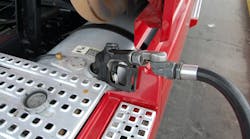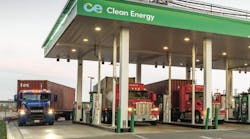Diesel and gasoline prices continued to climb this week, with average retail pump prices increasing 2.4 cents and 7 cents per gallon, respectively, across this U.S., according to data tracked by the Energy information Administration (EIA).
The agency said diesel now stands a U.S. average of $3.89 per gallon after this week’s 2.4 cent per gallon jump, though that retail pump price is 6.6 cents per gallon lower compared to the same week in 2012. EIA added that diesel prices increased in every region of the country except New England, where prices dropped 4/10ths of a penny to $3.991 per gallon.
Diesel prices are highest in California right now at $4.072 per gallon after climbing 3 cents this week, the agency noted, with the West Coast, not including California, witnessing a 4.9 cent spike to $3.932 per gallon, while the Gulf Coast saw a 3.6 cent spike pushed average retail pump prices to $3.773 per gallon.
U.S. average retail pump prices for gasoline jumped 7 cents to $3.673 per gallon, EIA noted, though that’s 4.2 cents cheaper compared to the same week in 2012. The Lower Atlantic is the only region where prices decreased, falling 8/10ths of a penny to $3.427 per gallon. By contrast, gasoline prices rose in every other region of the nation, jumping a whopping 18.8 cents to $3.866 per gallon in the Midwest and 11.2 cents to $3.672 per gallon for the Rocky Mountains.
Though fuel prices only recently started increasing again, a survey by Bankrate.com found that 80% of Americans have not increased their discretionary spending despite gasoline price declines in the first half of 2013.
Last year, elevated gas prices led 59% of Americans to decrease their non-essential spending. In 2011, when gas prices were also at elevated levels, 63% of Americans cut back, the firm said.
Between late February and late April 2013, gas prices in many parts of the U.S. dropped by 30 cents per gallon – nearly 7% – and though both gasoline and diesel cost less at this point in time compared to 2012, Greg McBride, Bankrate.com's senior financial analysis, stressed that recent price declines have provided little "oomph" to the economic recovery.
“Only 17% of Americans have increased their non-essential spending as a result of the recent drop in gas prices – a reading is consistent across age, education and income levels,” he added.
On a positive note, a report from the EIA indicated that U.S. ethanol production capacity remains relatively stable at 13.9 billion gallons per year or 903,000 barrels per day, which is important as ethanol is required to be mixed into gasoline to help reduce tailpipe emissions.
The agency said there’s been actually very slight increase in the total capacity of operating ethanol plants compared 2012, with most of the existing fuel ethanol capacity is located in the Midwest (PAD District 2 or “PADD 2”).
On a strict one-for-one comparison basis, a total of 193 ethanol plants were operating as of January 1 this year compared to 194 plants operating in January 1, 2012, with about 91% ethanol production located in PADD 2, EIA said.



